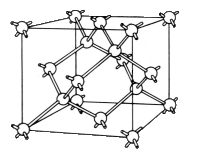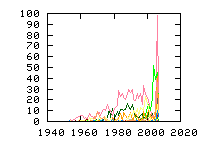« Previous
1
Next »
(8 hits, 1/1)
Showing
10, 25, 50, 100, 500, 1000, all papers per page.
Sort by:
last publication date,
older publication date,
last update date.
- 1. Phys. Rev. B 75, 085416 (2007) , “Ab initio theoretical study of hydrogen and its interaction with boron acceptors and nitrogen donors in single-wall silicon carbide nanotubes”, A. GaliSilicon carbide nanotubes have a great potential for biological applications. It is of interest to explore the electronic properties of these nanotubes, and how those are modified in the presence of impurities. Hydrogen is a common impurity that can appear during the growth of silicon carbide... (Read more)
- 2. Phys. Rev. B 75, 075202 (2007) , “Theoretical study of Li and Na as n-type dopants for diamond”, J. P. Goss and P. R. BriddonPhosphorus is the n-type dopant of choice for diamond, but results in a deep donor level and alternatives are being sought. One possibility is the incorporation of interstitial alkali metal impurities such as Li and Na. We present the results of density-functional calculations used to predict... (Read more)
- 3. Phys. Rev. B 75, 035211 (2007) , “Self- and foreign-atom diffusion in semiconductor isotope heterostructures. II. Experimental results for silicon”, H. Bracht, H. H. Silvestri, I. D. Sharp, and E. E. HallerWe report the diffusion of boron, arsenic, and phosphorus in silicon isotope multilayer structures at temperatures between 850 °C and 1100 °C. The diffusion of all dopants and self-atoms at a given temperature is modeled with the same setting of all native-point-defect-related parameters.... (Read more)
- 4. Physica B 340-342, 15-24 (2003) , “Defects in SiC”, E. Janz?n, I. G. Ivanov, N. T. Son, B. Magnusson, Z. Zolnai, A. Henry, J. P. Bergman, L. Storasta, F. CarlssonRecent results from studies of shallow donors, pseudodonors, and deep level defects in SiC are presented. The selection rules for transitions between the electronic levels of shallow donors in 4H–SiC in the dipole approximation are derived and the ionization energy for the N donor at... (Read more)
- 5. Phys. Rev. B 66, 161202(R) (2002) , “Phosphorus and sulphur doping of diamond”, L. G. Wang and Alex ZungerPrevious calculations on n-type doping of diamond by P and S predicted that S has a shallower level and a higher solubility than P. Our first-principles calculations show that the opposite is true: Phosphorus impurity in diamond gives rise to a shallower donor level, and has a higher bulk solid... (Read more)
- 6. Phys. Rev. B 64, 235202 (2001) , “Photosensitive electron paramagnetic resonance spectra in semi-insulating 4H SiC crystals”, E. N. Kalabukhova, S. N. Lukin, A. Saxler, W. C. Mitchel, S. R. Smith, J. S. Solomon, A. O. EvwarayePhotosensitive electron paramagnetic resonance (EPR) investigations of unintentionally doped, semi-insulating (s.i.) 4H?SiC have been made at 37 GHz and 77 K including photoexcitation and photoquenching experiments. In the dark the EPR spectrum consists of a low intensity line due to boron on the... (Read more)
- 7. phys. stat. sol. (a) 162, 95-151 (1997) , “EPR and ENDOR Investigations of Shallow Impurities in SiC Polytypes”, S. Greulich-WeberInvestigations of nitrogen donors in 6H-, 4H- and 3C-SiC using conventional electron paramagnetic resonance (EPR), electron nuclear double resonance (ENDOR) and optical detection of EPR and ENDOR as well as optical absorption and emission spectroscopy are reviewed and critically discussed. An... (Read more)
- 8. Solid State Physics 5, 258-319 (1957) , Academic Press, New York (Edited by F. Seitz, D. Turnbull) , “Shallow Impurity States in Silicon and Germanium”, W. KohnI. Introduction (p.258): II. Emprical Properties (p.261): 1. Energy Levels (p.261), a. Ionization Energies, b. Spectra of Excited States, 2. Spin Resonance (p.266), a. Electron Spin Resonance, b. Double Resonance, 3. Static Magnetic Susceptibility (p.271), III. Structure of Donor States (p.271): 4. Conduction Bands of Silicon and Germanium (p.271), a. Silicon, b. Germanium, 5. Effective Mass Theory of Donor States (p.274), a. Single Band Minimum at k=0, b. Several Conduction Band Minima, c. Matrix Elements for Radiative Transitions, 6. Numerical Results and Comparison with Experiments (p.285), a. Energy Levels, b. Wave Functions, 7. Corrections to the Effective Mass Formalism (p.289), a. General Considerations, b. Corrected Wave Functions, c. Comparison with Experiment, IV. Structure of Acceptor States (p.297): 8. Valence Bands of Silicon and Germanium (p.297), a. Silicon, b. Germanium, 9. Effective Mass Equations for Acceptor States (p.300), 10. Approximate Solutions and Comparison with Experiment (p.301) a. Germanium b. Silicon V.Effects of Strains and of Static Electric and Magnetic Fields (p.306): 11. Strains (p.306) a. Donor States, b. Acceptor States, 12. Stark Effect (p.311)
« Previous
1
Next »
(8 hits, 1/1)
Showing
10, 25, 50, 100, 500, 1000, all papers per page.
Sort by:
last publication date,
older publication date,
last update date.
All papers (3399)
Updated at 2010-07-20 16:50:39
Updated at 2010-07-20 16:50:39
(view as: tree
,
cloud
)
| 1329 | untagged |
Materials
(111 tags)
Others(101 tags)
Technique
(46 tags)
Details
(591 tags)
Bond(35 tags)
Defect(interstitial)(18 tags)
Defect(vacancy)(15 tags)
Defect-type(19 tags)
Element(65 tags)
Energy(8 tags)
Isotope(56 tags)
Label(303 tags)
Sample(17 tags)
Spin(8 tags)
Symmetry(15 tags)

